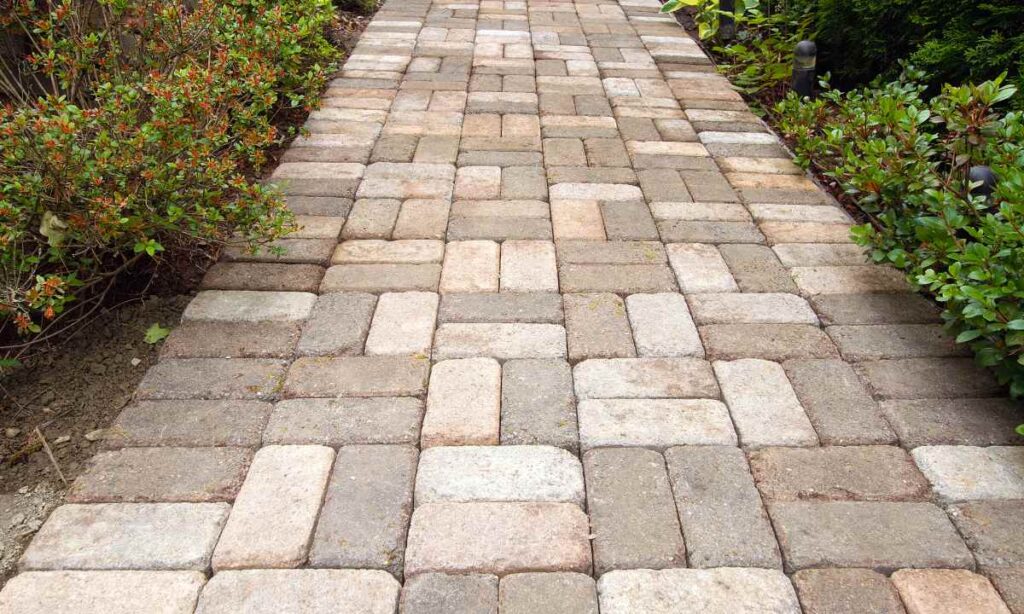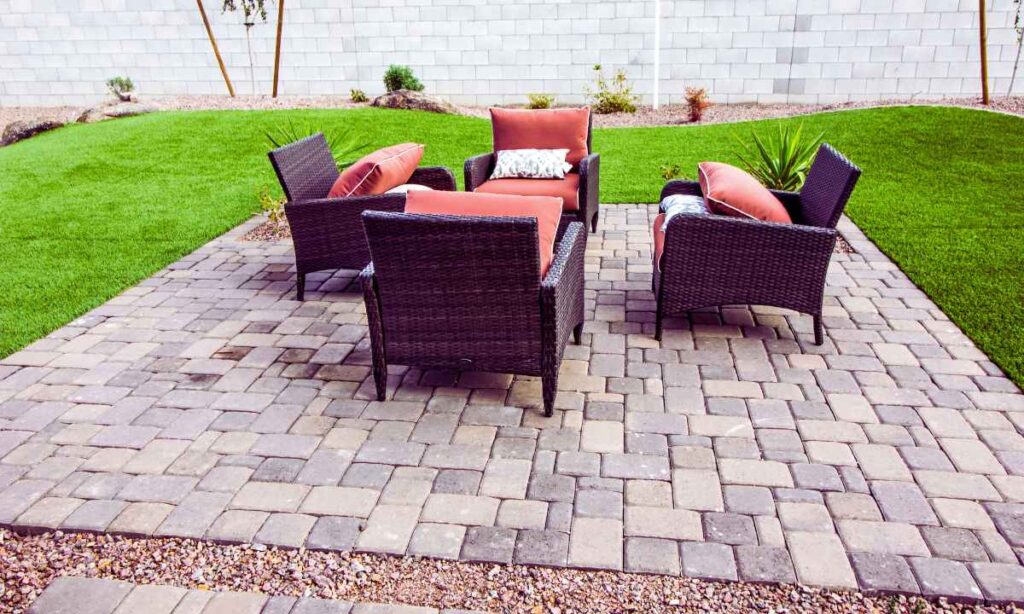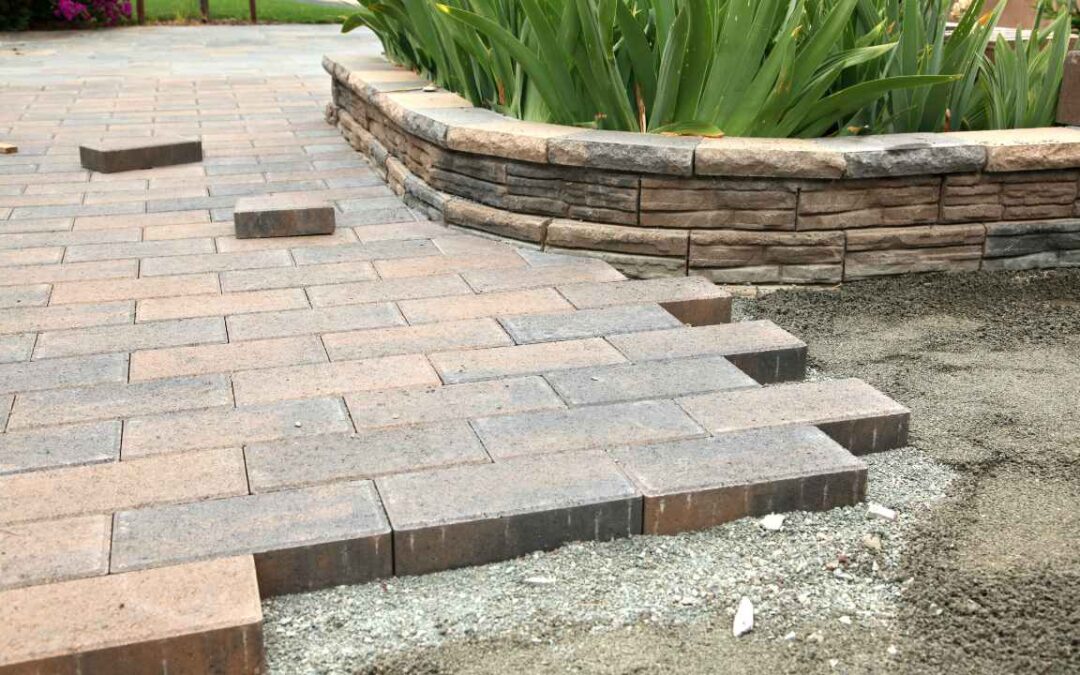Pavers are modular paving units used for driveways, patios, and walkways but not all pavers are built for winter. Here in St. Louis, winters bring a unique challenge. Between freeze-thaw cycles, heavy moisture, and the occasional snowstorm, your outdoor surfaces take a real beating. It’s not just the cold—it’s what happens when snow melts, water seeps into small cracks, and then freezes again. That expansion can push pavers up, shift their alignment, or even crack them if they’re not properly prepared.
This guide breaks down how different paver materials respond to winter stress, what installation techniques matter most, and the smart decisions homeowners can make to avoid costly issues later. Whether you’re building a new patio, refreshing your walkway, or redoing the driveway, understanding St. Louis’s winter impact is key to getting lasting value.
By the end, you’ll know what works, what to avoid, and how to make winter-ready choices that actually hold up. Let’s dive in.
What Every St. Louis Homeowner Should Know About Pavers in Winter
If you’re planning a patio, driveway, or walkway in St. Louis, the winters here aren’t just a seasonal nuisance they’re a critical factor in how your pavers will perform long-term. Cold weather alone isn’t the problem. It’s the repeated freeze-thaw cycles, the moisture that gets trapped beneath the surface, and the local soil conditions that together determine whether your paver project thrives or fails.
Here’s what you really need to know before investing in pavers in this region:
-
Concrete, clay, and natural stone pavers each behave differently in freezing conditions. Concrete pavers are popular and cost-effective but must be sealed and installed properly to resist cracking. Clay bricks are denser and naturally frost-resistant. Some natural stones perform well others, not so much.
-
A bad install will ruin even the best pavers. It’s not just about the paver material it’s about the base, drainage, jointing, and slope. If those are wrong, frost heave and surface failure are practically guaranteed.
-
Sealing your pavers and prepping a proper base matters more than the paver itself. A well-compacted gravel base, proper edge restraint, and polymeric sand make a massive difference during winter.
-
Winter-friendly paver materials must meet freeze-thaw durability standards. Look for ASTM-rated products (like ASTM C936 for concrete pavers), especially if they’re imported.
-
Hiring ICPI-certified pros in the St. Louis area lowers your risk. Local installers who understand our soil (often clay-heavy) and moisture levels will design a paver system that lasts through many winters.
-
Polymeric joint sand and solid edge restraints prevent most shifting and washout. These details might seem small, but they’re the difference between a clean patio in spring—or a costly repair.
When it comes to St. Louis winters, it’s not a question of whether pavers can survive it’s whether you’re using the right materials, prep, and expertise. Get those three things right, and your outdoor space will stay beautiful long after the last snow melts.
How St. Louis Winters Really Affect Outdoor Pavers

St. Louis doesn’t just get cold it cycles between cold and not-so-cold, over and over again. That’s where the real trouble starts for outdoor paver surfaces.
What Does Winter in St. Louis Really Do to Outdoor Surfaces?
You’re not just dealing with snow. You’re dealing with a freeze-thaw battlefield. In St. Louis, average winter temperatures dip into the 20s and 30s°F. That’s cold enough to freeze water, but not consistently cold enough to stay frozen. Instead, moisture in and around your pavers freezes at night and thaws during the day sometimes multiple times in a week.
Now, water expands about 9% when it freezes. If that water is sitting inside porous paver material or underneath in the base layer, it pushes things around. Cracks, heaving, and lifted edges follow. And once the damage starts, it compounds every winter.
St. Louis also averages around 18 inches of snow each year, meaning surfaces stay wet longer perfect conditions for freeze-thaw damage to escalate.
Why Freeze-Thaw Cycles Are the #1 Enemy of Pavers
Here’s the thing: the pavers themselves aren’t always to blame. The real issue is what gets into them and what’s underneath them.
-
Unsealed or porous pavers soak up water like sponges.
-
Improper joint sand lets water sit and seep below.
-
Lack of edge restraint allows the pavers to shift as the ground expands and contracts.
It’s not about one big freeze it’s death by a thousand tiny ones. Every cycle adds pressure. Every gap lets in more water. And without the right prep and protection, you’ll be staring at a buckled patio by March.
Cold Climate Paver Myths What Most Guides Get Wrong
Most online guides skip over the real causes of winter paver failure and some spread bad advice altogether. Let’s set the record straight.
Myth 1: “Concrete pavers always crack in winter.”
Not true. Cracking isn’t about the material alone it’s about how it’s installed. A proper base with drainage and frost-rated materials will outlast poured concrete in most cases.
Myth 2: “You don’t need to seal pavers in cold climates.”
Wrong again. In freeze-thaw zones like St. Louis, unsealed pavers absorb moisture. That water freezes, expands, and causes heaving. Sealing is a must for long-term durability.
Myth 3: “Any contractor can install pavers for winter.”
Plenty of contractors treat pavers like a summer-only project. But winter performance comes down to base prep, joint stability, and product knowledge especially in clay-heavy St. Louis soils. Always look for ICPI-certified pros.
Myth 4: “Natural stone is better than manufactured pavers.”
Depends on the stone. Granite and slate hold up well, but softer options like travertine or sandstone often fail in winter. Imported stone without frost ratings is a big risk.
Bottom line:
Durability in winter is more about system design base, slope, drainage, and jointing than the paver itself. This section helps reframe the conversation, giving readers better questions to ask and mistakes to avoid.
Which Paver Materials Handle St. Louis Winters Best?
Not all pavers are created equal and in a climate like St. Louis, the material you choose can make or break your outdoor space. Let’s break down how the most common paver types stack up when the temperature drops.
Concrete, Clay, or Natural Stone: What’s Right for You?
| Material | Durability | Freeze Resistance | Maintenance | Cost |
|---|---|---|---|---|
| Concrete Pavers | Moderate | Good (if sealed) | Medium | Affordable |
| Clay Brick Pavers | High | Excellent | Low | Mid-range |
| Natural Stone | Very High (varies) | Depends on type | High | Expensive |
- Concrete pavers are the most common and for good reason. They’re affordable, come in many styles, and hold up well if properly sealed. But that’s the catch: if left unsealed, they can absorb water and crack when frozen.
- Clay brick pavers are denser and more resistant to moisture. They’re fired at high temperatures, making them less porous and less prone to cracking in the freeze-thaw cycle. Plus, they age beautifully think classic brick walkways that have lasted for decades.
- Natural stone pavers like granite or slate can be excellent but only if you pick the right type. Granite holds up well, while softer stones like sandstone or travertine don’t belong in freezing climates. These stones look great on warm-weather patios but struggle with winter moisture. for more information you can check our guide on Which Paver Works Best Concrete vs Brick vs Stone.
Pavers That Struggle in Cold Climates
Here’s the thing: travertine, marble, and soft limestones might look high-end but they’re not made for freeze-thaw cycles. Water seeps in easily, freezes, expands, and slowly tears the stone apart from the inside.
Also, many imported pavers especially budget options aren’t tested for frost resistance. If the product isn’t certified under ASTM C902 (clay) or C936 (concrete) for freeze-thaw durability, skip it.
Your best bet? Ask where it’s made and what it’s rated for. If the supplier can’t give you a straight answer, that’s your sign to walk away.
Why Pavers Fail in St. Louis Winters (and How to Prevent It)
It’s not always the paver that fails it’s the installation shortcuts that come back to bite. Many of the problems people see after winter aren’t material flaws; they’re the result of skipping critical steps during install.
Frost Heave Isn’t Random — It’s Poor Prep
Reddit post: “Our pavers started heaving after just one winter. Contractor said it was normal. Is that true?”
No, it’s not. When pavers lift, shift, or crack, the base is usually to blame.
-
Shallow base layers (less than 4–6 inches of compacted gravel) can’t handle freeze-thaw movement.
-
No geotextile fabric = soil migration and instability.
-
If it wasn’t sloped for drainage, trapped water freezes and expands, lifting the pavers from beneath.
These issues don’t fix themselves over time they get worse.
Washed Out Sand = Wobbly Surfaces
If your contractor used regular sand instead of polymeric sand, winter will wash it away.
-
Rain and meltwater erode the joints, leaving gaps.
-
Once gaps form, ice builds up, and pavers shift or pop out of place.
Polymeric sand hardens like grout once wet it’s the easiest upgrade most installs skip.
How Salt and De-Icers Damage Your Pavers in Winter
Yes, de-icers and salt can absolutely damage paver surfaces over time especially if you’re using the wrong type or applying it too often. St. Louis homeowners use salt to stay safe in winter, but few realize how much harm it can do to their driveways, walkways, and patios.
Here’s what happens:
-
Salt breaks the freeze-thaw cycle faster, causing rapid expansion and contraction in the joints and base layers. That leads to cracking, flaking, or spalling especially in unsealed concrete pavers.
-
Many de-icers are chemically aggressive and will erode sealants and paver surfaces over time. Products with ammonium nitrate or ammonium sulfate are especially harsh on concrete and clay.
-
Excess salt attracts more moisture into the joints, especially if polymeric sand wasn’t used. That moisture then freezes and pushes pavers apart from underneath.
If your pavers aren’t sealed, or if your base prep wasn’t done right, winter salt can turn a solid install into a buckling mess by spring.
Tips for safer winter maintenance:
-
Use calcium magnesium acetate or pet-safe de-icers, which are less corrosive.
-
Sweep off excess salt after snow melts don’t let it sit for days.
-
Reapply sealant every 2–3 years to protect against salt intrusion and chemical wear.
Pavers can survive winter salt but only if you build and maintain them properly. Don’t skip the details when prepping for St. Louis winters.
| Feature | Winter-Ready Install | Problem-Prone Install |
|---|---|---|
| Paver Type | Freeze-rated concrete, clay, or granite | Soft or porous materials |
| Base Prep | Deep gravel base, geotextile, proper slope | Shallow base, poor drainage |
| Joint Sand | Polymeric sand (resists moisture + weeds) | Regular sand (washes out, traps moisture) |
| Edge Restraints | Installed and secured | Missing or loose |
| Sealant | Applied pre-winter and every 2–3 years | Never sealed or overdue |
| De-Icer Use | Calcium magnesium acetate or pet-safe blends | Rock salt, ammonium nitrate or sulfate |
| Maintenance | Post-winter cleaning and resealing plan | No follow-up maintenance |
Why Some Pavers Fail in St. Louis (and Others Don’t)
Winter damage isn’t just about freezing temperatures it’s about what’s under and around your pavers. Inconsistent performance usually comes down to a few overlooked details.
Poor Base Prep Is the #1 Culprit
If there’s no compacted gravel base (at least 4–8 inches), pavers have nowhere to drain. In clay-heavy St. Louis soil, that trapped moisture freezes and lifts everything. That’s frost heave and it’s totally preventable.
No Geotextile Fabric? Expect Shifting
Contractors sometimes skip the fabric layer between the soil and base. That’s a mistake. Geotextile keeps the layers stable and stops soil from mixing in. It’s essential for long-term durability in the Midwest.
Bad Slope = Ice Build-Up
Water needs a place to go. If your patio or driveway isn’t sloped properly (at least 1/8” per foot), snowmelt pools and refreezes underneath leading to cracks and surface damage.
Joint Sand Matters More Than You Think
Basic sand washes away, freezes, and invites weeds and movement. Polymeric sand locks in the joints, resists washout, and keeps the surface stable. Without it, winter finds its way in.
How to Winter-Proof Your Paver Installation in St. Louis

Don’t just pick the right pavers build them to survive.
The biggest paver failures in winter aren’t about the product. They’re about the prep work. Here’s how to make sure your patio, walkway, or driveway holds up when St. Louis freezes over.
Start With a Solid Base
A shaky base is a fast track to frost heave.
-
Use ¾” minus crushed stone (not pea gravel), compacted in 3–4″ lifts to reach a depth of 4–8 inches depending on traffic load.
-
Add a geo-fabric layer underneath if you have clay-heavy soil, which is common in parts of the STL area.
-
Always grade for drainage—a slope of at least 1/8″ per foot helps meltwater run off instead of pooling.
Seal Before the First Snow
This isn’t optional it’s protection.
-
Apply a penetrating sealer to reduce water absorption and prevent salt and freeze damage.
-
Reapply every 2–3 years for consistent coverage.
-
Look for breathable formulas that won’t trap moisture beneath the surface.
Use Polymeric Sand and Edging for Joint Stability
Your joints are your weak point. Reinforce them.
-
Use polymeric sand, not basic play sand it hardens, locks in place, and resists washout and weed growth.
-
Add edge restraints around all exposed sides to prevent lateral movement and keep the whole surface tight through freeze-thaw shifts.
Choosing the Right Pavers for St. Louis Winters
Not all pavers are created equal especially in the Midwest.
Choosing the right material is half the battle. The other half? Knowing where it came from and how it was made. Here’s how to make smart paver decisions that hold up when the temperature drops.
What to Ask Before You Buy
-
Is the paver freeze-thaw tested? Look for ASTM standards like C936 (concrete) or C902 (clay brick) for frost resistance.
-
Is it locally sourced or imported? Local products are often better suited to the climate and soil.
-
Is there an ICPI certification or manufacturer warranty? These give you peace of mind on durability and performance.
-
What sealants or joint materials are recommended? Don’t just ask about the paver—ask about the system.
Before committing to any patio, driveway, or walkway material, ask your supplier or contractor these cold-weather questions. Explore our expert paver installation services to ensure your St. Louis project is built for winter resilience.
Trusted Paver Brands and Distributors in Missouri
Skip the generic big-box stuff. These local and regional options offer better support, better materials, and climate-smart products:
-
Belgard – Well-known for freeze-resistant concrete pavers; large local distributor network.
-
Pavestone – Offers modular, durable products with good availability throughout Missouri.
-
Local natural stone yards – For granite, bluestone, or slate, always choose a Missouri-based quarry or distributor that understands our climate conditions.
For homeowners planning a new outdoor space, check out these local patio construction tips.
Common Questions About Pavers in Cold Climates
These are the top questions people ask when planning outdoor projects that need to hold up in freezing weather.
Do pavers crack in cold weather?
Yes, if they’re not freeze-thaw rated or properly sealed.
Water can seep into porous pavers, then freeze and expand causing cracks or surface scaling. This is especially common with unsealed concrete pavers.
Are pavers better than concrete for St. Louis winters?
Yes, when installed correctly. Pavers flex with the freeze-thaw cycle and can be repaired individually. Poured concrete slabs, on the other hand, are prone to large cracks that are harder to fix.
Can pavers withstand snow plows?
Yes, but use a rubber-edged blade and secure edge restraints. Loose or poorly installed pavers can pop up under the force of a plow. Edge restraints and joint stability are key for keeping everything in place.
How do I keep pavers from shifting in winter?
Use a proper base, slope, edge restraint, and polymeric sand. Most shifting happens because the foundation wasn’t prepped for freeze-thaw cycles or drainage was ignored.
Are heated pavers worth it in Missouri?
They can be, but only if installed with the right sub-base and insulation. For steep driveways or mobility concerns, heated pavers reduce snow buildup. But costs are high, and not every paver type supports heating systems.
Building Cold-Resilient Outdoor Spaces in STL
St. Louis winters are rough on outdoor surfaces. But with the right prep and materials, pavers can absolutely hold their ground even when temps drop, snow piles up, and the freeze-thaw cycles kick in.
Here’s what matters most:
-
Use pavers rated for freeze-thaw durability. Stick with concrete, clay, or granite that’s ASTM-tested and proven in cold climates.
-
Prep your base like it matters — because it does. That means a deep gravel layer, proper slope, geotextile fabric, and reliable edge restraints.
-
Seal your pavers before winter hits, especially if you’ve got concrete. Reseal every couple of years.
-
Choose polymeric sand over plain jointing sand it locks in stability and keeps out moisture.
-
Hire local pros who actually understand Missouri clay soils and how St. Louis winters attack outdoor surfaces.
A good paver installation isn’t about guessing. It’s about knowing how local weather and ground conditions interact and building to outlast them. Thinking about adding a patio, driveway, or walkway? Talk to a local paver contractor in St. Louis who knows these winters inside and out. It’s the difference between costly repairs and year-round curb appeal.
